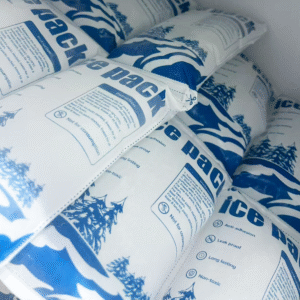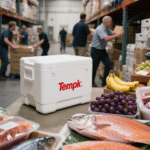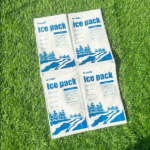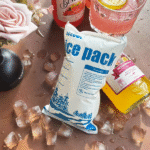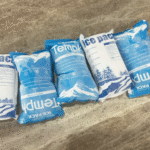So verwenden Sie Trockeneisbeutel für den Versand von Meeresfrüchten: Ein vollständiger Leitfaden
Beim Versand von Meeresfrüchten muss sorgfältig auf die Temperaturkontrolle geachtet werden. Damit Ihre Meeresfrüchte ihr Ziel frisch und sicher zum Verzehr erreichen, Trockeneisbeutel sind ein unverzichtbares Hilfsmittel. Diese Verpackungen sind besonders beim Versand von Meeresfrüchten über große Entfernungen von Vorteil, wo die Aufrechterhaltung einer kalten Temperatur von entscheidender Bedeutung ist. In diesem Handbuch wird die Verwendung erläutert Trockeneisbeutel für Meeresfrüchte und gewährleistet die besten Versandpraktiken.
-
Warum Trockeneisbeutel für den Versand von Meeresfrüchten von entscheidender Bedeutung sind.
-
So wählen Sie den richtigen Trockeneisbeutel für Ihre Meeresfrüchtelieferungen aus.
-
Welche Sicherheitsmaßnahmen sollten Sie bei der Verwendung von Trockeneis beachten??
-
Welche Vorteile bietet die Verwendung von Trockeneisbeuteln gegenüber anderen Kühloptionen??
Warum Trockeneisbeutel für den Versand von Meeresfrüchten verwenden??
Trockeneisbeutel bieten eine wirksame Lösung zur Aufrechterhaltung niedriger Temperaturen beim Transport von Meeresfrüchten. Trockeneis, Das ist festes Kohlendioxid (Co₂), sublimiert bei -78,5°C, Dadurch entsteht ein kühlender Effekt, der perfekt für Meeresfrüchte geeignet ist, das gefroren oder bei niedriger Temperatur bleiben muss, um ein Verderben zu verhindern. Durch die Wahl des richtigen Trockeneisbeutels, Sie können sicherstellen, dass die Meeresfrüchte von A bis B frisch bleiben.
Der Hauptvorteil von Trockeneis beim Versand von Meeresfrüchten besteht darin, dass es den Inhalt kalt hält, ohne dass eine Kühlung erforderlich ist. Im Gegensatz zu herkömmlichem Eis, Trockeneis schmilzt nicht in Wasser, Dadurch wird das Risiko einer nassen Verpackung, die Meeresfrüchte beschädigen könnte, eliminiert. Zusätzlich, Trockeneis kann die erforderlichen niedrigen Temperaturen über längere Zeiträume aufrechterhalten, Damit eignet es sich ideal für den Versand über große Entfernungen.
| Merkmal | Beschreibung | Vorteile für Meeresfrüchte |
|---|---|---|
| Temperaturbereich | -78.5°C | Hält Meeresfrüchte bei langen Transporten gefroren |
| Sublimationsrate | 5-10 Pfund pro Stück 24 Std. | Sorgt für eine gleichmäßige Temperaturkontrolle |
| Versandvorschriften | Vorbehaltlich der DOT- und IATA-Regeln | Entspricht den Sicherheitsstandards |
Auswahl des richtigen Trockeneisbeutels für Meeresfrüchte
Beim Versand von Meeresfrüchten, Die Auswahl des richtigen Trockeneisbeutels ist von entscheidender Bedeutung. Die ideale Packungsgröße hängt von der Art und Menge der Meeresfrüchte ab, sowie die Lieferzeit. Allgemein, Größere Mengen an Meeresfrüchten erfordern größere Verpackungen, um eine Temperaturkontrolle während der gesamten Transportzeit zu gewährleisten.
Für Übernachtsendungen, ein kleinerer Trockeneisbeutel könnte ausreichen, da es die Meeresfrüchte kühl hält 24-48 Std.. Für längere Lieferzeiten, Verwenden Sie größere Packungen, um über längere Zeiträume eine gleichmäßige Kühlung zu gewährleisten. Zur Optimierung der Kühlleistung können auch mehrere kleinere Packs verwendet werden. Für empfindliche Meeresfrüchte wie Austern oder Fisch, Zur Aufrechterhaltung einer stabilen Temperatur können zusätzliche Isolierung oder mehrere Trockeneisbeutel erforderlich sein.
Best Practices für die Verwendung von Trockeneisbeuteln beim Versand von Meeresfrüchten
-
Verstehen Sie die Temperaturbedürfnisse Ihrer Meeresfrüchte: Unterschiedliche Meeresfrüchte erfordern unterschiedliche Temperaturkontrollen. Zum Beispiel, Garnelen benötigen möglicherweise eine kältere Umgebung als andere Fischarten.
-
Berechnen Sie die Menge an benötigtem Trockeneis: Berücksichtigen Sie die Versanddauer und die Umgebungstemperatur. Allgemein, Je mehr Trockeneis Sie verwenden, desto länger bleiben Ihre Produkte kalt.
-
Stellen Sie eine ordnungsgemäße Verpackung sicher: Verwenden Sie isolierte Behälter, um die Kühlwirkung von Trockeneis zu maximieren. Auch die Verpackung sollte belüftet sein, damit die Sublimationsgase sicher entweichen können.
Wie halten Trockeneisbeutel Meeresfrüchte frisch??
Trockeneisbeutel wirken, indem sie in Kohlendioxidgas sublimieren, Wärme aus der Umgebung aufnehmen. Das feste Trockeneis wird zu Gas, Es entsteht ein Kühleffekt, der die Temperatur der Meeresfrüchte senkt und sie gefroren hält.
Der Kühleffekt hält länger an als bei normalem Eis, da Trockeneis nicht zu Wasser schmilzt, verhindert, dass Meeresfrüchte nass werden. Dies ist besonders nützlich für den Versand von gefrorenen Meeresfrüchten über große Entfernungen, da die Temperatur bis zur Auslieferung konstant bleibt.
Beispielszenario
Beim Versand von Hummer oder Krabben, Trockeneis kann die erforderlichen Gefriertemperaturen aufrechterhalten und gleichzeitig sicherstellen, dass die Meeresfrüchte während des Transports nicht auftauen. Dies ist besonders wichtig für die Erhaltung der Textur und des Geschmacks der Produkte.
Sicherheitsmaßnahmen bei der Verwendung von Trockeneis
Während Trockeneis sehr effektiv ist, Um die Sicherheit zu gewährleisten, ist eine ordnungsgemäße Handhabung erforderlich. Hier sind die wichtigsten Sicherheitsvorkehrungen:
-
Belüftung: Trockeneis setzt Kohlendioxidgas frei, was in schlecht belüfteten Bereichen gefährlich sein kann. Lagern und versenden Sie Trockeneis immer in gut belüfteten Behältern.
-
Schutzausrüstung: Behandeln Sie Trockeneis mit isolierten Handschuhen, um Erfrierungen durch den Kontakt mit dem extrem kalten Material zu vermeiden.
-
Verpackung und Etikettierung: Stellen Sie sicher, dass Ihre Verpackung haltbar ist und kennzeichnen Sie die Verpackung als Trockeneis enthaltend. Eine ordnungsgemäße Etikettierung trägt dazu bei, dass Spediteure ihre Sendungen sorgfältig behandeln.
| Sicherheitsüberlegungen | Aktion | Warum ist es wichtig |
|---|---|---|
| Belüftung | In gut belüfteten Räumen verwenden | Verhindern Sie CO₂ -Aufbau, das kann gefährlich sein |
| Schutzausrüstung | Tragen Sie beim Umgang mit Trockeneis Handschuhe | Vermeiden Sie Erfrierungen und Verletzungen |
| Verpackung & Beschriftung | Belüftete Behälter verwenden und ordnungsgemäß kennzeichnen | Sorgen Sie für einen sicheren Umgang und die Einhaltung der Vorschriften |
2025 Trends in der Meeresfrüchteschifffahrt
Die Schifffahrtsbranche für Meeresfrüchte entwickelt sich mit der Entwicklung neuer Technologien und Strategien zur Verbesserung der Kühlkettenlogistik weiter. Hier sind einige der Trends für 2025:
Smartemperaturüberwachung
Einsatz von Sensoren, die die Temperatur von Meeresfrüchtelieferungen in Echtzeit verfolgen. Dadurch wird sichergestellt, dass das Produkt während des gesamten Transports die erforderliche Temperatur behält.
Nachhaltige Verpackung
Da die Umweltbedenken zunehmen, Unternehmen setzen auf umweltfreundliche und biologisch abbaubare Verpackungslösungen, Reduzierung des CO2-Fußabdrucks von Versandprozessen.
Innovationen in der Schifffahrtstechnologie
-
Temperaturempfindliche Verpackung: Fortschritte bei Verpackungsmaterialien tragen dazu bei, niedrige Temperaturen über längere Zeiträume aufrechtzuerhalten, Bereitstellung zuverlässigerer und kostengünstigerer Lösungen.
-
Blockchain für Rückverfolgbarkeit: Die Blockchain-Technologie sorgt für mehr Transparenz und Rückverfolgbarkeit in der Kühlkette, Unterstützung von Unternehmen bei der Bestätigung, dass Meeresfrüchte während des Versandprozesses ordnungsgemäß gehandhabt wurden.
Markteinsichten
Da die Nachfrage der Verbraucher nach frischen und nachhaltigen Meeresfrüchten wächst, Unternehmen investieren in bessere Kühlkettenlösungen. Es wird erwartet, dass der weltweite Kühlkettenmarkt größer wird $700 Milliarden von 2025, angetrieben durch Fortschritte in der Kühl- und Verpackungstechnologie.
Häufig gestellte Fragen
Q1: Wie verpackt man Meeresfrüchte am besten mit Trockeneis??
Verwenden Sie für Trockeneis immer einen isolierten Behälter mit ausreichender Belüftung. Stellen Sie sicher, dass die Meeresfrüchte dicht verpackt sind und sich nicht bewegen, da Bewegung zum Auftauen führen kann.
Q2: Wie lange hält Trockeneis Meeresfrüchte während des Transports gefroren??
Mit Trockeneis können Meeresfrüchte bis zu gefroren bleiben 48 Std., abhängig von der Packungsgröße und der Umgebungstemperatur. Bei längerer Versanddauer werden größere Packungen empfohlen.
Schlussfolgerung und Empfehlungen
Zusammenfassend, Trockeneisbeutel sind ein entscheidendes Element für den Versand von Meeresfrüchten, um sicherzustellen, dass es frisch und sicher für den Verzehr bleibt. Indem Sie die richtige Größe wählen und Sicherheitsrichtlinien befolgen, Sie können sicherstellen, dass Ihre Meeresfrüchte-Lieferungen in einwandfreiem Zustand ankommen.
Nächste Schritte:
-
Wählen Sie den Trockeneisbeutel in der passenden Größe für Ihre Meeresfrüchte-Lieferung.
-
Stellen Sie sicher, dass bei der Handhabung und Verpackung von Trockeneis alle Sicherheitsprotokolle befolgt werden.
-
Investieren Sie in fortschrittliche Überwachungstechnologie, um die Temperaturen während des Transports zu verfolgen.
Über Tempk
Und Tempk, Wir sind auf die Bereitstellung zuverlässiger Trockeneisbeutel spezialisiert, die auf die Fischindustrie zugeschnitten sind. Mit langjähriger Erfahrung und dem Anspruch an qualitativ hochwertige Lösungen, Wir sorgen dafür, dass Ihre Meeresfrüchte-Lieferungen frisch sind, sicher, und pünktlich geliefert.






